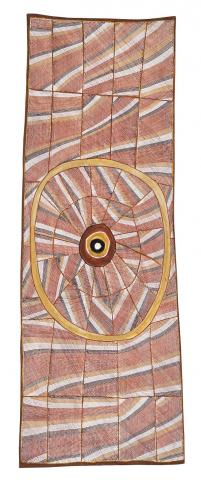MARDAYIN DESIGN, 2003
JOHN MAWURNDJUL
natural earth pigments on eucalyptus bark
145.0 x 54.0 cm (irregular)
Maningrida Arts and Culture, Northern Territory
Private collection, Melbourne
This painting is accompanied by a certificate of authenticity from Maningrida Arts and Culture, Northern Territory (catalogue number342-03).
It reads in part, 'This work by the artist concerns a major patrimoiety of a secret nature called 'Mardayin'. Much of the meaning of the iconography in the painting is not in the domain of public knowledge and so it cannot be explained in detail here. The painting refers to a site, Kakodbebuldi, which is an outstation in Dangkorlo clan estate in the Mann River region. Kakodbebuldi is a Mardayin ceremony performance site and is located on a large billabong covered in waterlilies. This place is about 50km south of Maningrida in central north Arnhem Land.'
rarrk: John Mawurndjul, Journey Through Time in Northern Australia, Museum Tinguely, Basel, 2005, p. 43
Culture Warriors: National Indigenous Art Triennial 07, National Gallery of Australia, Canberra, pp. 17–20
Laverty, C., Laverty, E., and Kleinmeyer, J., Beyond Sacred: Recent painting from Australia's remote Aboriginal communities; The collection of Colin and Elizabeth Laverty, Hardie Grant Books, Prahran and Bambra Press, Melbourne, p. 276
With an artistic career spanning over thirty years John Mawurndjul is one of Australia's most successful and innovative contemporary artists.
Mawurndjul has had a meteoric career. In 1981 he was included in a group exhibition in Paris, Les magicians de la terre at the centre Georges Pompidou, then followed by a solo exhibition in 1991 at Gallery Gabrielle Pizzi, Melbourne. His work was featured in the 12th Biennale of Sydney in 2000 and in 2002 he won the bark painting prize at the National Aboriginal & Torres Strait Islander Art Award, Darwin. In 2003, he was the first indigenous artist to win the Clemenger Contemporary Art Award held at the National Gallery of Victoria and in the following year his works of art were included in Crossing country: the alchemy of western Arnhem Land, at the Art Gallery of New South Wales.
In 2005 his retrospective rarrk opened at Musé e Jean Tinguely, Basel, Switzerland and then travelled to the Sprengel Museum, Hanover, Germany. During 2005 and 2006 Mawurndjul worked on a major commission at the Musée du quai Branly, Paris, where he painted a column and designed the ceiling in the library. In 2007 he was represented at Cornice, Venice art fair with William Mora Galleries and that same year was included in the first National Indigenous Art Triennial: Culture Warriors at the National Gallery of Australia, Canberra.
Born at Mumeka, which is located near the Mann River in Central Arnhem Land, an important site for the Kurulk clan, Mawurndjul's early painting lessons were painting bodies for dance or initiation ceremonies. He had a very traditional up-bringing and is a very competent and knowledgeable hunter. His strong cultural interest in his heritage is evident in his art.
'I saw my father doing the rarrk for the Mardayin ceremony and tried to do it myself with my back all doubled over, I ended up being better than any of them at it. They gave me a job in the Mardayin ceremony to paint some rarrk. When they all saw me doing it they said 'wow', he's got the hang of it. 'you've left us behind my son', they said to me.'
Mawurndjul is a truly gifted painter, which was seen early on in his career. He was guided by his elder brother Jimmy Njiminjuma and his uncle Peter Marralwanga and today passes his knowledge and monitors the development of his children and his niece Irenie Ngalinba who is the daughter of his late brother Jimmy Njiminjuma.
Originally painting mythological figures such as the Ngaloyd, (rainbow serpent) he has over recent years developed a more abstract style with many grid forms interlocking over the entire surface, as depicted in Mardayin Design, where the complex composition of Mawurndjul's intricate rarrk skills is evident.
This work refers to a site called Kakodbebuldi, an outstation in Dangorlo clan estate near the Mann River region around 50km south of Maningrida in Central North Arnhem Land and is the Mardayin ceremony performance site; a ceremony of secret nature and is rarely performed today; a ceremony where Mawurndjul was initiated. At this site there is a substantial billabong covered in waterlilies.
Mawurndjul is constantly finding new styles to interpret his country through the use of rarrk "same, same but different... I just can't stop thinking about my paintings... They are very important places for us, they have meanings..."
It is the representation of important locations and mapping within his clan site and djang that is most important to him. His work is highly influential and an exception within the art movement; a passionate teacher, he was instrumental in making Kuninjku men accept the Kuninkju women as painters within their community and in their own right.
